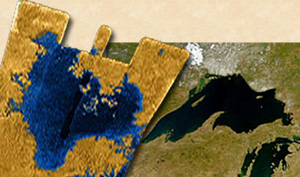 A comparison of one of Titan's 'seas'(left)
A comparison of one of Titan's 'seas'(left)
and Lake Superior. Credit: NASA/Cassini.Saturn's largest moon, Titan, has always held my imagination in a tight grip.
Even back in my childhood (we're talking the 60's, before any interplanetary probe had even crossed the Asteroid Belt just beyond Mars), when we knew little more about Titan than its large size and the possibility that it might have clouds, I was spellbound. After all, the fewer hard facts you have, the more power your imagination has, right?
I read science fiction stories that presented Titan as a world with atmosphere, weather, clouds, and even seas of liquid (albeit seas of water and a breathable atmosphere...).
In retrospect, how prophetic some of those stories were. In the past two years, NASA's Cassini spacecraft, now wrapping up its third year in orbit around Saturn, has revealed features on Titan that, in my mind, place it into the class of world. (Not planet, of course; even before the word planet was defined scientifically, Titan wasn’t one simply because it orbits an actual planet, and not the Sun.)
Early in 2005, the European Space Agency's Huygens probe, which was deposited on Titan by mothership Cassini, sent back aerial pictures of features on Titan’s surface that looked for all the world like meandering coastlines. These "coastlines" divided areas of land etched with what looked like river drainage networks and dark, flat expanses that gave the impression of being some sort of liquid surface. Huygens’ measurements also suggested that the ground on which it touched down may have been more like damp soil rather than dry desert dust and rock such as we've found on Venus and Mars.
